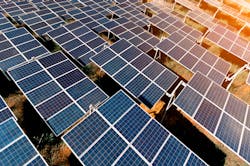Solar PV Growth Breaks Records in Q1 but Module Defects Also Increasing
The solar photovoltaic market in the United States is breaking records, particularly for systems at utility scale, but concerns are cropping up about the reliability of the systems being installed, two reports released this week show.
The United States installed 2.7 gigawatts (GW) of solar photovoltaics (PV) in the first quarter of 2019, making it the most solar power ever installed in the first quarter of a year, according to a report released this week by research firm Wood Mackenzie Power & Renewables and the Solar Energy Industries Association (SEIA).
The first quarter, which is typically the slowest quarter for solar installations, also saw installed PV in the U.S. market pass the milestone of 2 million installations altogether. With the strong first quarter, Wood Mackenzie forecasts 25% growth in 2019 compared to 2018, and it expects more than 13 GW of installations this year.
The “U.S. Solar Market Insight Report” found that the largest share of installations during the quarter came from the utility PV segment, with 1.6 GW coming on-line, making up 61% of PV capacity installed. The report notes that with 4.7 GW of large scale projects under construction, 2019 is on track to be a strong year for utility PV, with 46% growth over 2018 expected.
According to the report, the U.S. saw 603 megawatts (MW) of residential solar installations during the first quarter, up 6% annually, while the non-residential segment, which includes commercial, industrial and public sector distributed solar, saw 438 MW of PV installed in the quarter, down on both a quarterly and annual basis. According to the report, the decline in growth is largely a result of state-level policy reforms in historically strong markets for the segment including California, Massachusetts and Minnesota.
At the same time, an annual study released by chemical giant DuPont found that the reliability of solar PV modules is a growing problem worldwide. DuPont’s “Global PV Reliability Study, 2019 Field Analysis,” which tracks material degradation and its effect on PV module performance, found defects in 34% of the modules tested, an increase from its previous field study.
The DuPont report said that, while there were no defects in the majority of module materials, it found a variety of defects in the installed systems, ranging from corrosion and hot spots in the module cells and interconnects, cracking and delamination in the module backsheets, discoloration of encapsulants and glass defects.
The study focuses on backsheet reliability because that’s the part DuPont produces, but it also offers a look at the various ways PV modules fail. For example, its researchers found that higher temperatures cause backsheet defects to accelerate and are 75% greater for roof installations than ground installations, as roof-mounted systems typically run 15°C
(59°F) higher than ground-mounted systems.
The industry’s growth trajectory is expected to continue. The Wood Mackenzie/SEIA study forecast that total installed U.S. PV capacity will more than double over the next five years, with annual installations reaching 16.4 GW in 2021 before the expiration of the residential federal Investment Tax Credit (ITC) and a drop in the commercial tax credit to 10% for projects not yet under construction.
